F-actin-rich territories coordinate apoptosome assembly and caspase activation during DNA damage-induced intrinsic apoptosis
- PMID: 36920061
- PMCID: PMC10162420
- DOI: 10.1091/mbc.E22-04-0119
F-actin-rich territories coordinate apoptosome assembly and caspase activation during DNA damage-induced intrinsic apoptosis
Abstract
The actin cytoskeleton is a ubiquitous participant in cellular functions that maintain viability, but how it controls programmed cell death is not well understood. Here we show that in response to DNA damage, human cells form a juxtanuclear F-actin-rich territory that coordinates the organized progression of apoptosome assembly to caspase activation. This cytoskeletal compartment is created by the actin nucleation factors JMY, WHAMM, and the Arp2/3 complex, and it excludes proteins that inhibit JMY and WHAMM activity. Within the territory, mitochondria undergo outer membrane permeabilization and JMY localization overlaps with punctate structures containing the core apoptosome components cytochrome c and Apaf-1. The F-actin-rich area also encompasses initiator caspase-9 and clusters of a cleaved form of executioner caspase-3 but restricts accessibility of the caspase inhibitor XIAP. The clustering and potency of caspase-3 activation are positively regulated by the amount of actin polymerized by JMY and WHAMM. These results indicate that JMY-mediated actin reorganization functions in apoptotic signaling by coupling the biogenesis of apoptosomes to the localized processing of caspases.
Figures

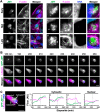
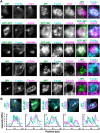
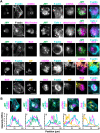
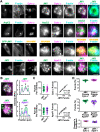
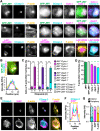
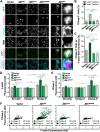
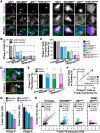

Similar articles
-
The actin nucleation factors JMY and WHAMM enable a rapid Arp2/3 complex-mediated intrinsic pathway of apoptosis.PLoS Genet. 2021 Apr 19;17(4):e1009512. doi: 10.1371/journal.pgen.1009512. eCollection 2021 Apr. PLoS Genet. 2021. PMID: 33872315 Free PMC article.
-
WHAMM Directs the Arp2/3 Complex to the ER for Autophagosome Biogenesis through an Actin Comet Tail Mechanism.Curr Biol. 2015 Jun 29;25(13):1791-7. doi: 10.1016/j.cub.2015.05.042. Epub 2015 Jun 18. Curr Biol. 2015. PMID: 26096974 Free PMC article.
-
Apoptosome: a platform for the activation of initiator caspases.Cell Death Differ. 2007 Jan;14(1):56-65. doi: 10.1038/sj.cdd.4402028. Epub 2006 Sep 15. Cell Death Differ. 2007. PMID: 16977332 Review.
-
LC3 and STRAP regulate actin filament assembly by JMY during autophagosome formation.J Cell Biol. 2019 Jan 7;218(1):251-266. doi: 10.1083/jcb.201802157. Epub 2018 Nov 12. J Cell Biol. 2019. PMID: 30420355 Free PMC article.
-
Apaf-1: Regulation and function in cell death.Biochimie. 2017 Apr;135:111-125. doi: 10.1016/j.biochi.2017.02.001. Epub 2017 Feb 9. Biochimie. 2017. PMID: 28192157 Review.
Cited by
-
The Proliferation of Chang Liver Cells After Simulated Microgravity Induction.Curr Issues Mol Biol. 2025 Feb 27;47(3):164. doi: 10.3390/cimb47030164. Curr Issues Mol Biol. 2025. PMID: 40136418 Free PMC article.
-
WHAMM functions in kidney reabsorption and polymerizes actin to promote autophagosomal membrane closure and cargo sequestration.bioRxiv [Preprint]. 2024 Jan 23:2024.01.22.576497. doi: 10.1101/2024.01.22.576497. bioRxiv. 2024. Update in: Mol Biol Cell. 2024 Jun 1;35(6):ar80. doi: 10.1091/mbc.E24-01-0025. PMID: 38328079 Free PMC article. Updated. Preprint.
-
The actin and microtubule network regulator WHAMM is identified as a key kidney disease risk gene.Cell Rep. 2025 Apr 22;44(4):115462. doi: 10.1016/j.celrep.2025.115462. Epub 2025 Mar 25. Cell Rep. 2025. PMID: 40138314 Free PMC article.
-
Branching out in different directions: Emerging cellular functions for the Arp2/3 complex and WASP-family actin nucleation factors.Eur J Cell Biol. 2023 Jun;102(2):151301. doi: 10.1016/j.ejcb.2023.151301. Epub 2023 Mar 2. Eur J Cell Biol. 2023. PMID: 36907023 Free PMC article.
-
WHAMM functions in kidney reabsorption and polymerizes actin to promote autophagosomal membrane closure and cargo sequestration.Mol Biol Cell. 2024 Jun 1;35(6):ar80. doi: 10.1091/mbc.E24-01-0025. Epub 2024 Apr 10. Mol Biol Cell. 2024. PMID: 38598293 Free PMC article.
References
-
- Ahn JS, Jang IS, Kim DI, Cho KA, Park YH, Kim K, Kwak CS, Chul Park S (2003). Aging-associated increase of gelsolin for apoptosis resistance. Biochem Biophys Res Commun 312, 1335–1341. - PubMed
-
- Bock FJ, Tait SWG (2020). Mitochondria as multifaceted regulators of cell death. Nat Rev Mol Cell Biol 21, 85–100. - PubMed
-
- Bolte S, Cordelières FP (2006). A guided tour into subcellular colocalization analysis in light microscopy. J Microsc 224, 213–232. - PubMed
Publication types
MeSH terms
Substances
Grants and funding
LinkOut - more resources
Full Text Sources
Research Materials

